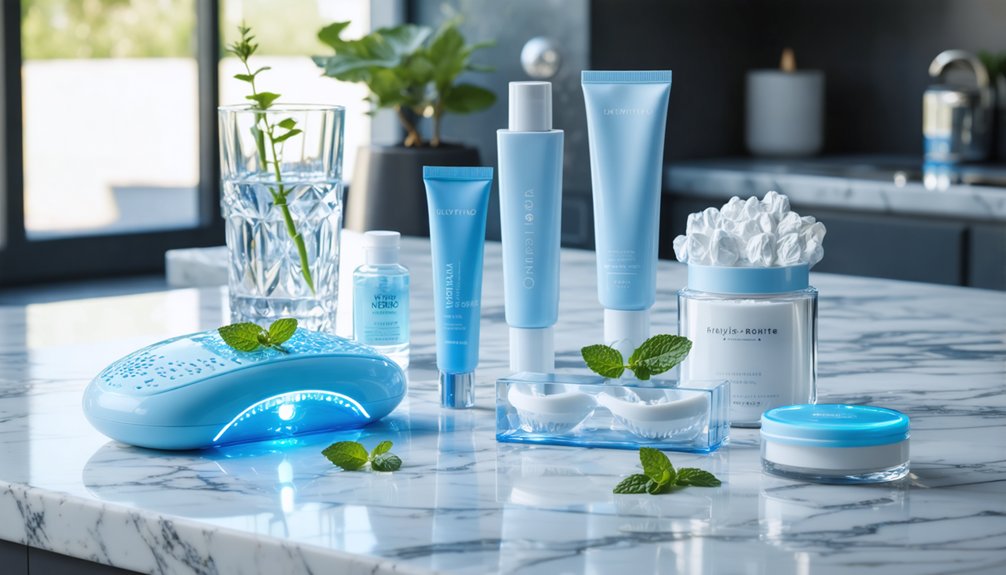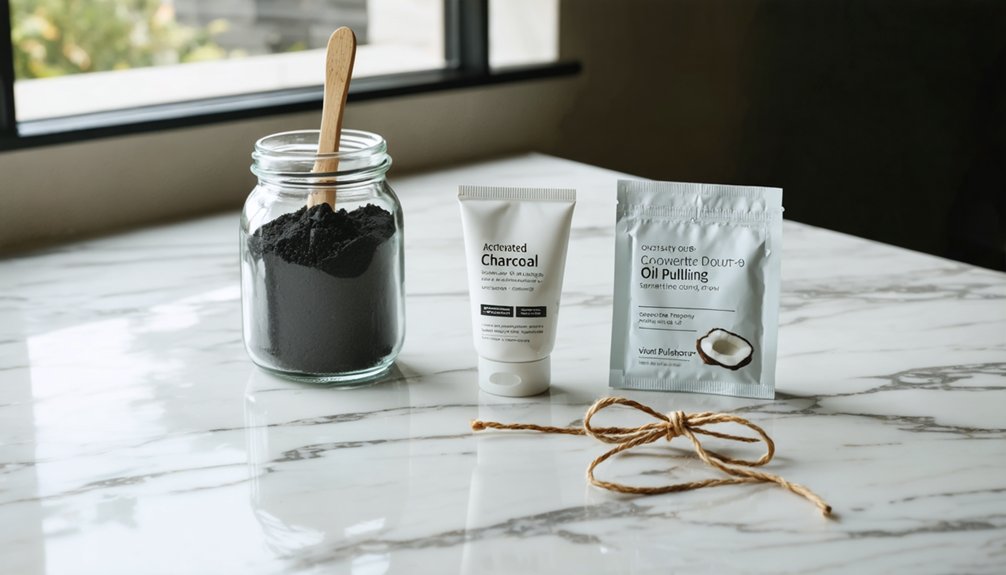If you have sensitive teeth, you’ll want to start with low-concentration whitening products containing desensitizing ingredients like potassium nitrate and stannous fluoride. Consider sensitivity-safe whitening toothpastes, gradual whitening strips with 5-6% peroxide, or professional treatments that offer controlled application and monitoring. Use desensitizing toothpaste for 2 weeks before starting any whitening regimen. A dentist can determine the safest approach while helping you achieve noticeable results through proper evaluation and customized care.
Key Takeaways
- Use sensitivity-safe toothpaste containing potassium nitrate and stannous fluoride for two weeks before starting any whitening treatment.
- Choose gradual whitening strips with lower peroxide concentrations (5-6%) and follow shorter application times to minimize discomfort.
- Consider professional treatments with custom-fitted trays and desensitizing agents for controlled, monitored whitening under dental supervision.
- Try peroxide-free gel solutions or natural alternatives like coconut oil pulling for gentler whitening results.
- Schedule a dental evaluation to address existing issues and determine appropriate whitening options based on enamel condition.
Understanding Sensitive Teeth and Whitening Challenges
While many people desire whiter teeth, those with sensitivity face unique challenges during the whitening process. Sensitivity causes include worn enamel exposing dentin tubules, aggressive brushing, acidic foods, gum recession, and teeth grinding. Whitening consultation with a dentist ensures proper treatment selection.
When these underlying issues meet whitening agents like hydrogen peroxide, you’ll likely experience heightened discomfort. Over-the-counter products contain anywhere from 3-15% hydrogen peroxide concentrations.
During whitening duration of 24-48 hours or up to a week, whitening chemicals penetrate your enamel to remove stains but temporarily expose sensitive dentin. This exposure triggers sharp pain from temperature changes, sweets, or cold air.
Teeth whitening can cause brief sensitivity as chemicals break through enamel, leaving exposed dentin vulnerable to temperature and sweet triggers.
The process can cause reversible pulp inflammation, especially when using higher peroxide concentrations.
Professional treatments help control these effects through proper concentration management and gum protection, making the process more tolerable for sensitive individuals.
Gentle Over-the-Counter Whitening Solutions
When choosing over-the-counter whitening products for sensitive teeth, you’ll find that sensitivity-safe toothpastes containing potassium nitrate and stannous fluoride can effectively reduce discomfort while providing gradual whitening benefits. Custom-fitted trays provided by dentists offer superior gel retention and more predictable results.
Low-peroxide whitening strips, such as Crest 3D White Whitestrips Gentle Routine Kit, offer a controlled approach to brightening your smile without triggering significant sensitivity.
You can also consider peroxide-free gel solutions that incorporate gentle ingredients like PAP (phthalimidoperoxycaproic acid) for enamel-friendly whitening results. Natural alternatives like coconut oil and sage provide a soothing experience while working to enhance tooth brightness.
Sensitivity-Safe Whitening Toothpastes
For individuals with sensitive teeth, specialized whitening toothpastes offer a gentle yet effective solution through carefully balanced formulations.
These products contain key ingredients like potassium nitrate at 5% concentration to block sensitivity triggers, while incorporating safe whitening agents such as carbamide peroxide and baking soda.
Unlike common whitening myths, you don’t need harsh chemicals for results.
Leading brands like Sensodyne Extra Whitening and Arm & Hammer Sensitive combine fluoride for enamel protection with SLS-free formulas to prevent irritation.
The science focuses on dual action: desensitizing nerve endings while lifting stains through low-abrasion methods.
Regular dental check-ups help monitor your enamel health while using whitening products.
You’ll find these toothpastes particularly effective when used regularly, as they provide continuous protection while gradually improving tooth color through gentle, enamel-safe mechanisms.
Using these products twice daily for 2 minutes is recommended by dental professionals to achieve optimal results while preventing potential damage to sensitive teeth.
Gradual Whitening Strip Options
Beyond sensitivity-safe toothpastes, gradual whitening strips offer a targeted approach for those with reactive teeth. These gentle whitening solutions contain lower peroxide concentrations, typically 5-6%, which helps minimize discomfort while still delivering noticeable results over time. Most whitening strips are cost-effective alternatives compared to expensive professional treatments. Consulting with a dental professional first can help determine the most suitable whitening approach for your sensitivity level.
For ideal gradual results with sensitive teeth, follow these key protocols:
- Start with shorter application times of 5-30 minutes, spacing treatments further apart.
- Position strips carefully on dry teeth, avoiding gum contact to prevent irritation.
- Use fluoride rinses after treatment and wait 30 minutes before brushing to protect enamel.
If you experience heightened sensitivity, reduce frequency or discontinue use.
Remember to maintain proper hydration and avoid extreme temperature foods immediately after treatments to support your comfort throughout the whitening process.
Low-Peroxide Gel Solutions
Although professional-strength whitening gels can cause discomfort, low-peroxide alternatives offer a gentler approach for sensitive teeth.
These formulations, typically containing 6-16% hydrogen peroxide, deliver effective whitening while minimizing enamel dehydration and nerve sensitivity. You’ll find that many include protective ingredients like potassium nitrate to block sensitivity signals during treatment. Professional grade gels like LaserGlow have been trusted by 10,000 dental professionals worldwide for gentle yet effective whitening. Extreme temperatures can trigger increased sensitivity after whitening treatments, so it’s best to avoid very hot or cold substances.
The low peroxide benefits extend beyond comfort – these gels support gradual, sustainable whitening over multiple applications.
When applying, you’ll want to use controlled dosing through syringes or applicators to guarantee even coverage. For best results, follow the recommended application techniques: use custom trays, maintain short exposure times, and consider pre-treatment with desensitizing agents.
Clinical evidence shows these gentler formulas can achieve noticeable whitening within 1-2 weeks while protecting your sensitive teeth.
Professional Whitening Treatments for Sensitive Teeth
While many individuals with sensitive teeth hesitate to pursue teeth whitening, professional treatments offer safe and effective options specifically designed for their needs.
Through professional evaluations and custom whitening options, your dentist can create a treatment plan that minimizes discomfort while achieving peak results.
- In-office treatments utilize controlled applications of lower-concentration bleaching agents, with dentist monitoring to prevent sensitivity.
- Custom-fitted trays combined with desensitizing agents guarantee precise gel application and enhanced comfort.
- Gradual whitening protocols with gentler formulas allow your teeth to adjust while still achieving up to 7-10 shades lighter.
Your dentist will assess your sensitivity levels, monitor progress, and make immediate adjustments if needed.
They’ll also incorporate protective measures like fluoride rinses and remineralizing agents to support your enamel throughout treatment.
Managing Sensitivity During the Whitening Process

You’ll need to take preventive steps before whitening by using desensitizing toothpaste containing potassium nitrate and fluoride for 1-2 weeks prior to treatment.
During the whitening process, you should carefully monitor any discomfort and immediately remove excess gel that contacts your gums to prevent increased sensitivity.
If you experience sharp pain during application, it’s crucial to reduce the concentration of whitening agents or decrease treatment duration while maintaining room-temperature conditions for ideal comfort.
Pre-Treatment Desensitizing Steps
Before beginning any teeth whitening treatment, implementing proper desensitizing steps can greatly reduce discomfort and improve overall results. Start using desensitizing pre-treatment toothpaste containing potassium nitrate at least two weeks before your procedure, as this creates a protective barrier against sensitivity.
For ideal preparation and protection, you’ll want to:
- Schedule professional treatments like fluoride varnishes or calcium phosphate applications 1-2 weeks before whitening.
- Avoid acidic foods, extreme temperatures, and aggressive brushing during the pre-treatment phase.
- Allow your dentist to apply specialized desensitizing gels immediately before the whitening procedure.
These evidence-based steps help strengthen your enamel, seal microscopic tubules, and create a buffer against the acidic effects of whitening agents, ensuring a more comfortable experience for your patients.
Monitoring Pain During Application
Managing sensitivity effectively during teeth whitening requires systematic monitoring and prompt intervention. During treatment, you’ll need to track sensitivity onset, intensity, and duration to make necessary adjustments.
Pay attention to patients reporting white or sore gums within 24 hours, as this indicates irritation requiring immediate attention.
Your sensitivity tracking should focus on the first period after application when discomfort typically peaks. Implement regular pain assessments to detect any escalation in symptoms, which affect 30-78% of patients.
If sensitivity increases, you can modify the treatment by reducing peroxide concentration or application time. Watch for temperature sensitivity and guide patients to avoid hot/cold foods and drinks.
Maintaining detailed records of patient responses enables you to optimize treatment protocols while ensuring comfort and effectiveness.
Natural and Alternative Whitening Methods
Several natural whitening methods offer gentler alternatives for individuals with sensitive teeth.
Oil pulling with coconut oil provides a safe approach due to its antimicrobial properties, while a carefully measured baking soda paste can help remove surface stains when used sparingly.
For effective and safe natural whitening, consider these evidence-based approaches:
- Perform oil pulling for 15-20 minutes daily using coconut oil, which helps reduce plaque without damaging enamel.
- Use ADA-approved whitening toothpaste containing natural ingredients and desensitizing agents.
- Avoid acidic fruits and abrasive scrubs, including charcoal-based products, as they can worsen sensitivity and damage enamel.
Remember to monitor any sensitivity during these treatments and discontinue use if discomfort occurs.
Focus on gentle, consistent application rather than aggressive treatments for best results.
Dental Health Considerations Before Starting Treatment

A thorough dental evaluation serves as the cornerstone of any safe and effective teeth whitening treatment.
You’ll need to address existing dental issues before proceeding, as cavities and gum disease can increase sensitivity and compromise results.
During your dental evaluation, your dentist will assess your treatment history, including any crowns, veneers, or previous whitening attempts.
Prior whitening treatments and existing dental work must be carefully reviewed to determine the most appropriate whitening approach for your smile.
Your dentist should examine your enamel thickness and identify any intrinsic staining that may affect treatment outcomes.
If you have a history of tooth sensitivity, they’ll need to tailor the approach accordingly, possibly incorporating desensitizing agents.
Professional cleaning may be recommended first to remove surface stains and provide a clear baseline for treatment.
Remember that untreated dental problems can worsen with whitening agents, making this pre-treatment assessment essential for your oral health.
Frequently Asked Questions
How Long Should I Wait Between Different Types of Whitening Treatments?
You’ll need to wait six months between professional treatments and 48-72 hours between at-home applications. Customize treatment intervals based on sensitivity levels to maintain whitening safety.
Can Medications Affect the Success of Teeth Whitening Treatments?
Like a stain embedded in fabric, your medications can considerably impact whitening effectiveness. Antibiotics, antidepressants, and blood pressure drugs affect both treatment success and sensitivity through medication interactions with bleaching agents.
Are There Specific Foods That Can Help Naturally Maintain Whitening Results?
You’ll maintain whiter teeth by eating natural whiteners like crunchy fruits, vegetables, and dairy products. Smart food choices include apples, carrots, cheese, and light-colored produce to prevent new stains.
Do Whitening Treatments Work Differently on Crowns or Dental Implants?
Like a stone statue unmoved by rain, your crowns and implants won’t respond to whitening treatments. They’ll maintain their original shade while natural teeth whiten, potentially creating color mismatches requiring crown replacement.
What Age Is Considered Appropriate to Start Teeth Whitening Treatments?
You’ll want to follow whitening age guidelines and wait until you’re at least 14-15 years old, when your permanent teeth have fully erupted and matured, to guarantee safe whitening practices.
References
- https://www.sensodyne.com/en-us/oral-health-tips/whitening-sensitive-teeth/what-to-know/
- https://www.44thstdental.com/how-to-whiten-sensitive-teeth/
- http://www.goochlanddentistry.com/whats-the-best-teeth-whitener-for-sensitive-teeth/
- https://www.goodrx.com/conditions/dental-care/sensitive-teeth-after-whitening
- https://www.drbobsdentalcare.com/is-teeth-whitening-safe-for-sensitive-teeth/
- https://pmc.ncbi.nlm.nih.gov/articles/PMC4058574/
- https://www.ada.org/resources/ada-library/oral-health-topics/whitening
- https://www.modernagedentistry.com/blog/teeth-whitening-for-sensitive-teeth-what-to-expect
- https://www.manateekidsdentist.com/does-teeth-whitening-hurt/
- https://admcare.com/teeth-whitening-for-sensitive-teeth-facts-and-fiction/



